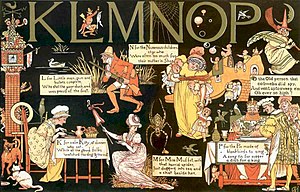Toy book
The earliest toy books were typically paperbound, with six illustrated pages and sold for sixpence; larger and more elaborate editions became popular later in the century.
[3] In the mid-19th century, the primary publishers of toy books in London were Dean & Son, using popularly coloured chromolithographs for the illustrations.
[2] Vicki Anderson, author of The Dime Novel in Children's Literature, writes that toy books were both temptingly colourful and not instructive.
[5] When the market for toy books exploded, Evans began publishing them himself, choosing and commissioning the artists to design the illustrations.
[11] Walter Crane (1845–1905), Randolph Caldecott (1846–1886), and Kate Greenaway (1846–1901) are the best known illustrators of late-Victorian toybooks, and "did much to develop the sense, the shape, and the look of the modern picture book".
The Diverting History of John Gilpin, written by William Cowper and first published in 1785, was illustrated by Caldecott and carefully printed in bright colours by Evans.
[2] The more elaborate toy books, such as Walter Crane's The Baby's Opera, brought higher prices, selling for as much as five shillings.



